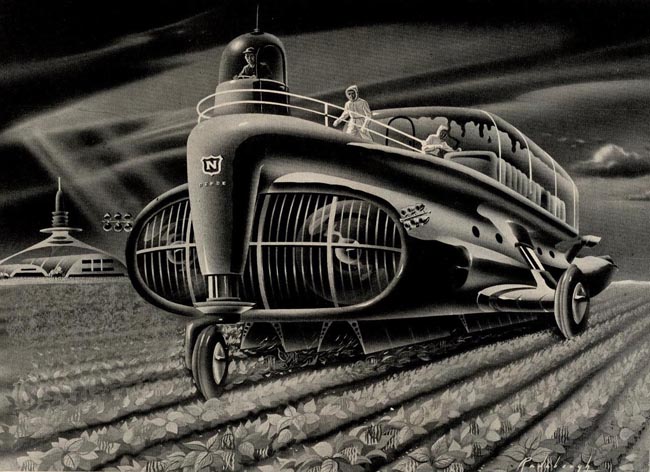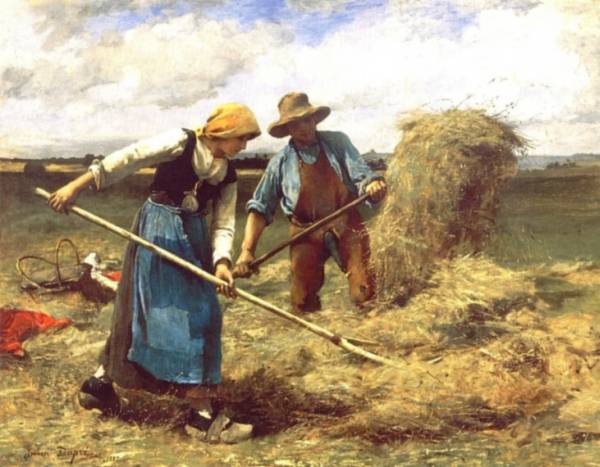|
You
can also view the message online
|
||||||||||||||||||||||||||
 Châtenay-Malabry (FR - 92290), June 1, 2020 EFITA newsletter / 932 - European Federation for Information Technology in Agriculture, Food and the Environment The informatique-agricole.org site now offers you the possibility of subscribing the RSS feeds of its two newsletters See RSS feeds to implement to ensure that you continue to receive this newsletter To unsubscribe this newsletter, please contact me directely: guy.waksman(a)laposte.net if this link Unsubscribe does not work. Please note that I changed the presentation of the links that are embedded in the name of the web service. 
To correspond with me (GW), please use this address: guy.waksman(a)laposte.net To subscribe the efita newsletter (please ask your friends and colleagues to test this link) Efita Newsletters subscription Weekly newsletters about ICT in Agriculture in English and French Both newsletters have around 14000 subscribers. >>> Last weekly EFITA Newsletters in English (created in 1999) Efita Newsletters >>> Last weekly AFIA Newsletters in French (created 20 years ago in 1997) Afia Newsletters Farewell BC (before coronavirus) Welcome AD (after domestication) Future of Biofuels 2020 22-23 September 2020, Copenhagen, Denmark Growing pressure to lower emissions and replace fossil fuels is leading to biggest ever range of biofuels such as ethanol, biodiesel and bio-methanol and other green fuels/ P2X. This green transition is a critical challenge facing the world. However, the decisions facing stakeholders such as producers, regulators and investors are complex. That is why we will tackle this raising question and make new ideas with market participants. Future of Biofuels 2020 is set to bring industry stakeholders, unique content, workshops and networking. Join us for newly researched agenda, latest market news, excellent keynote speakers & technical insights! See fortesmedia.com Jumping robot helps farming robotics take leap forward By combining the propellers of a quadcopter with an ingenious jumping mechanism, CropHopper is able to quickly travel across fields and work for much longer than a drone. It weighs 3kg, costs € 15/ha, can operate without an operator, it can work in-crop all season and it offers the potential to also automatically treat weeds, pests and diseases. See futurefarming.com SensoTerra launches new Multi Depth soil moisture sensor SensoTerra's new Multi Depth sensor comes with six soil moisture sensors in one device See futurefarming.com Subsidy to develop fully automated drone workforce Groningen University has been granted €600,000 to develop a fully automated drone workforce. See futurefarming.com Trimble adds Next Instruments to Trimble Select Trimble has added Australian Next Instruments to its Trimble Select network of technology providers. See futurefarming.com Digital Magazine This edition focuses on smart irrigation solutions. We also look at the latest developments in field robots and drones. And what will the tractor cabin of the future look like? Plus much, much more! Check it out! See Digital Magazine How we saw the future yesterday?
Archives of our newsletters in French and English Voir Afia Voir Efita
New precision ag platform predicts insects’ pressure The new Arc farm intelligence platform uses predictive modelling based on real-time data. See futurefarming.com CIMAT project on quest for multifunctional robots The cross-border project CIMAT aims to develop small scale multifunctional robots for agriculture. See futurefarming.com Research from Aarhus University, US universities and research organisations has investigated the use of drones for locating drain pipes See futurefarming.com Why is no one talking about agriculture as a solution to climate change? …/… Agriculture has only recently entered into the public conversation on climate change — and mostly in a negative way. Over the past few years, we’ve heard more about the environmental impact of meat and dairy production, deforestation for farm and grazing land, and the detrimental effects of chemical pesticides and fertilizers on ecosystems and waterways. Far less attention has been paid to agriculture’s capacity to be a climate solution. How? Through the production and maintenance of healthy living soil. The world’s soils contain 2,500 gigatons of carbon — more than three times more carbon than is currently in the atmosphere. And soil has the capacity to hold much more! …/… See agfundernews.com Land grant legacy drives innovation and entrepreneurship at Iowa State University See agfundernews.comv Israel’s Saturas secures an initial $3m of Series B funding, by Richard Martyn-Hemphill …the team at Saturas has developed a decision support system for precision irrigation based on its miniature stem-water potential (SWP) sensor. That means taking tiny moisture measurements by drilling a few millimeters into the tree or plant. This approach differs from other advanced irrigation management options, which rely on deploying sensors to test the moisture in the surrounding soil, or drawing assumptions from precipitation data, SWP has an advantage of being a better gauge of accurate irrigation, but farmers have tended to shun this method as too costly or cumbersome. …/… See precision irrigation Fram(x): we learned how to unlock the profitability in every field Farm(x) is a unique team of growers and technologists with more than 75 years of combined experience in agriculture and Ag related businesses. Our FIELD FIRST approach means grower experience drives our solution. We know that we must deliver trust in our service, reliability in our hardware and software, information not data to make action easy, and a measure of control in an industry that is constantly challenged. We customize our solution for each grower. And we sell it as a service - don’t buy or maintain the hardware or software. See farmx.co Good
old days (?????): The Wheatfield by Julien Dupré
(1) Agricultural Robots and AI: A Question of When and Not If (A copy of an E-mail that I received afew days ago…) Robotics and artificial intelligence (AI) will drive a deep and transformative change in the agricultural world during the coming decades. Seeing, localising, and taking plant-specific intelligent action are no longer the exclusive realm of humans. Machines have demonstrated the technical viability and the emphasis has long shifted to the finer details of ROI, reliability, business model, etc. As such, a new class of activities in agriculture are prone to automation, just as advances in power and motion technologies mechanized many agricultural tasks, or just as advances in seed and agrochemical technology removed the human from many activities. The IDTechEx assessment is that the upcoming changes are already a question of when and not if. The transformation will not be overnight, but nonetheless, robotics and AI are an inevitability in the evolution of agricultural tools and practises. The scale of the potential is demonstrated in the chart below, which shows the forecasted long-term growth in annual unit sales (vs accumulated fleet size) of various autonomous and/or robotic solutions. In this article, IDTechEx Research provides an overview of the key product categories and discusses underlying technologies which are driving this change. For each, we offer our insights about the current and future technical and adoption status. IDTechEx Research has been examining the technologies, applications, products, and players active in agricultural robotics and AI for the past five years. The article is based on the IDTechEx report “Agricultural Robots, Drones, and AI: 2020-2040: Technologies, Markets, and Players”, which covers the latest developments and reflects our latest insights, analysis, and market projections. Indeed, this report analyses all the emerging product types, including autonomous robots taking plant-specific precision action, intelligent vision-enabled robotic implements, diverse robotic fresh fruit harvesters, highly automated and autonomous tractors and high-power farm vehicles, drones, automatic milking, and so on. It provides interview-based company profiles and analysis of all of the key companies and innovators. Finally, the report offers short- and long-term market forecasts, considering the addressable market size in area or tons and value, penetration rates, annual robot sales, accumulated fleet size, total RaaS (robot as a service) revenue projections and so on. The forecasts cover 15 robot types and farming sectors. (2) Agricultural Robots: A Cost-Effective Precision Revolution? Examples of these products or robots are shown below. These are often small or mid-sized robots which are designed to autonomously navigate and to automatically take some precise plant-specific action. Machine vision technology is often a core competency of these robots, enabling the robots to see, identify, localise, and to take some intelligent site-specific action on individual plants. The machine vision increasingly uses deep learning algorithms often trained on expert-annotated image datasets, allowing the technology to far exceed the performance of conventional algorithms and to match or even exceed even that of expert agronomists. Crucially, this approach enables a long-term technology roadmap, which can be extended to recognize all types of crops and to analyse their associated conditions, e.g., water-stress, disease, etc. Many versions of this emerging robotic class are autonomous. The autonomy challenge is much simpler than a car. The environment is well controlled and predictable, and the speed of travel is low. The legislation is today a hinderance, including in places such as California, but will become more accommodative relatively soon. The rise of autonomous robots, provided they require little remote supervision, can alter the economics of machine design, enabling the rise of smaller and slower machines. Indeed, this elimination of the driver overhead per vehicle is the basis of the swarm concept. There is clearly a large productivity gap today between current large and high-power vehicles and those composed of fleets of slow small robots. This productivity gap however can narrow as the latter has substantial room for improvement. The first major target market is in weeding. The ROI benefits here are driven by labour savings, chemical savings, boosted yields, and less land compaction. Precision action (spraying, mechanical, or electrical) reduces consumption of agrochemicals by 90% compared to untargeted application. It also improves yield (e.g., by 5-10%) because collateral damage of the crops by untargeted chemical application can be minimized. This technology can further enable farmers to tackle herbicide-resistant weeds, which are a growing problem, especially in some hotspots. Finally, the robots leave behind no unusable compacted soil. These robots are evolving. Many robots have already grown in size and capability, offering faster speeds, higher frame-per-seconds, more ruggedized designs, higher on-board energy for longer operation time and a heavier load, and so on. This evolution will inevitably continue, just as it did with all other agricultural tools and vehicles. We are still at the beginning. The deployed fleet sizes worldwide are small, but this is about to change.
(3) Intelligent Robotic Implements: The Inevitable Next Generation of Agricultural Tools Simple robotic implements utilising basic row-following vision technology are already mature and not uncommon in organic farms. Advances in vision technology are transforming tractor-pulled implements though, upgrading them into intelligent computerized tools able to take plant-specific precise action. The core technology here is also the machine vision, which enables the identification and the localization of specific plants. The algorithms already surpass the capabilities of agronomist in specific cases, e.g., weed amongst cotton. Crucially, the systems are becoming ever more productive (see image below), closing the productivity gap with established technology. This approach does not focus on autonomy, although the tractor itself can readily be made autonomous to render the entire system automatic if needed. This system is designed to become competitive in large farms, which demand high productivity, which in turn is linked to technology parameters such as fps (frame per second), false positives, sprayer controller speed, and so on. In the future, the system costs will likely fall, particularly if lighter versions of the algorithms on the inference side become available to render GPU processors unessential without a major performance sacrifice. (4) Autonomous Tractors and High-Power Vehicles: Fewer but More Autonomous Systems Will Be the Future? Autonomous navigation is not new to tractors. Thanks to RTK-GPS, tractors have long been benefiting from tractor guidance and autosteer. The latter is in fact level-4 autonomy since the tractor can autonomously drive outdoors along pre-determined GPS coordinates without human intervention. The cost of implementation, as well as the adoption of such technologies have increased. In short, the technical challenge does not hinder deployment. Level-5 or fully autonomous tractors have also been demonstrated for some years. The technical barrier here is low. The required hardware is available and the autonomous driving software challenges are relatively mild given the nature of the operational environment. As with all cases, the legislative environment is a hinderance today, but will not hold back the industry for long. The determining factors here are farmer perception and added value. In terms of the latter, the additional cost incurred in going from level-4 to level-5 does not justify the additional benefits, at least not yet. This is because level-5 does not currently enable many new possibilities. This will remain the case until more tasks, and not just movement, become automated. The rise of autonomous mobility is also giving rise to novel designs. Some examples are shown in the panel below. In particular, the weight distribution can be altered without scarifying the horsepower, helping alleviate soil compaction issues. In the longer term, though, other agricultural robots will eat into the tasks that tractors perform today, potentially denting overall demand.
Anti-pesticide activism has facilitated disastrous infestations of African crops. The West's Role in Africa's Day of the Locust, by Richard Tren & Jasson Urbach Those who think small-scale organic farming is friendlier to mother nature are wrong. Organic farmers use lots of pesticides. They’re simply “natural” ones, like copper sulfate or neem oil, which are highly toxic to people and wildlife. They’re also less effective against pests, so they have to use more of them. Modern pesticides are among the most carefully tested and regulated chemicals in use, and they are used increasingly in targeted, precise ways to limit wider environmental impacts. Most importantly, modern farming allows us to produce more food on less land. According to Rockefeller University’s Jesse Ausubel, US corn production has quintupled on the same amount of land. He estimates that if American farming techniques were to be adopted globally, an area the size of India could be returned to nature over the next 50 years. “Better Living Through Chemistry” was the catchy DuPont slogan of the 1960s. The slogan rings true for those of us living longer, healthier lives of plenty, with more food than at any time in human history. But if the campaigns against chemicals and the demonisation of modern agriculture are successful, these gains may well be reversed. Perhaps that’s the plan. Radical environmentalists have maintained that human beings are the problem. “Fewer Living Without Chemistry” might as well be the slogan of the modern environmentalist movement. See humanprogress.org Good old days (?????): Colheita - ceifeiras, pelo Antonio da Silva Porto, c. 1893. Museu Nacional de Soares dos Reis
How the world’s most powerful country is handling covid-19 Contrary to what many Americans think, the death rate in America is about the same as in Europe. America has passed a grim milestone: 100,000 deaths from a novel coronavirus that began to spread half a year and half a world away. Many Americans think their president has handled the epidemic disastrously, that their country has been hit uniquely hard and that there is a simple causal relationship between the two. The 100,000, which does not include excess deaths mistakenly attributed to other causes, is higher than any other country’s. It has routinely been compared with the 60,000 American casualties in the Vietnam war. A Trump Death Clock in Times Square purports to show how many lives the president’s ineptitude has cost: as we went to press it stood at 60,262. Yet this widespread conviction that America has failed because of Donald Trump is not supported by the numbers. Or, at least, not yet. .../... That America and Europe have fared similarly in the pandemic does not absolve Mr Trump. This is the first international crisis since 1945 in which America has not only spurned global leadership but, by cutting funds to the World Health Organisation, actively undermined a co-ordinated international response. That matters, as does Mr Trump’s inability to cleave to a consistent message or to speak to the country in words that do not enrage half of the population. Yet four years after Mr Trump was elected, the time to be surprised by his behaviour has long gone. Luckily, he has mattered less than most Americans think. See economist.com Good old days (?????): La vache bien gardée par Édouard Debat-Ponsan - 1847-1913
¿Por qué nos agotan psicológicamente las videoconferencias? Por JOSÉ MENDIOLA ZURIARRAIN Los expertos determinan que la ausencia de contacto físico exige más atención. Ver elpais.com
Good old days (?????): Paysanne dans un champ par Camille Pissaro (1882, Musée National des Beaux-Arts, Buenos Aires)
Virus jokes - Apparently one of the symptoms of Covid-19 is having no taste. Looking back on all my exes I think I have been infected for years... - Everything for summer is cancelled, may as well just put up the Christmas tree and call it a year! - During the Middle Ages they celebrated the end of the Plague with wine and orgies. Anyone know if they have anything similar planned for the end of Covid?
The distribution of this efita newsletter is sponsored by vitisphere.com Please, contribute to the content of your efita newsletter, and advertise your events, new publications, new products and new project in this newsletter. Without your support, it will not survive! Contact: Guy WAKSMAN E-mail: guy.waksman(a)laposte.net To read this newsletter on our web site See Afia The archives of this newsletter See Afia About the EFITA mailing list You can use the efita moderated list (> 15000 subscribers) to announce any event / product / web site / joke (!) related to IT in agriculture, environment, food industry and rural areas. If you want to subscribe a friend, please fill in his form. If you do not wish to receive our messages, please fill in the following form... |











